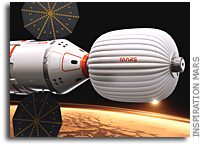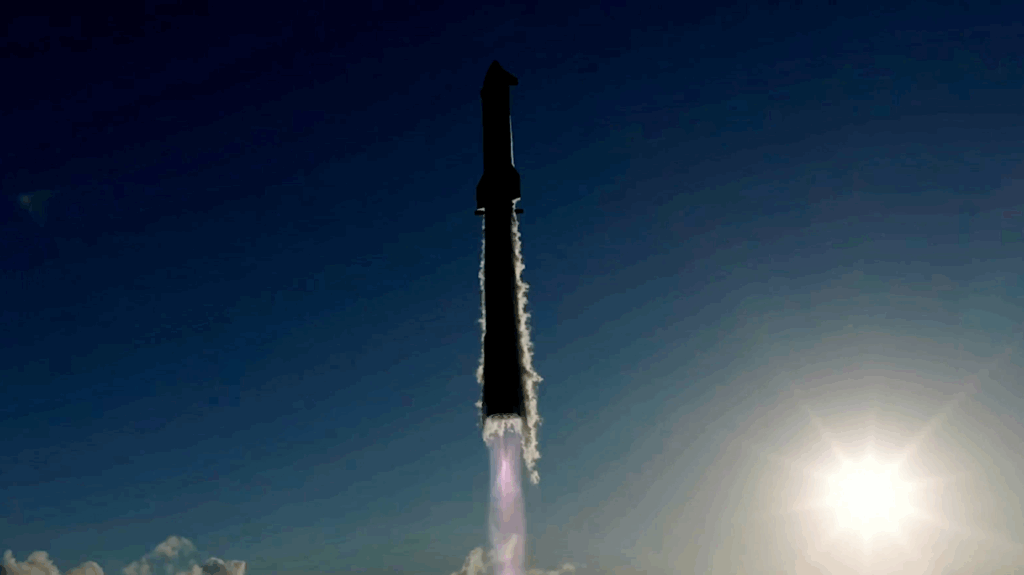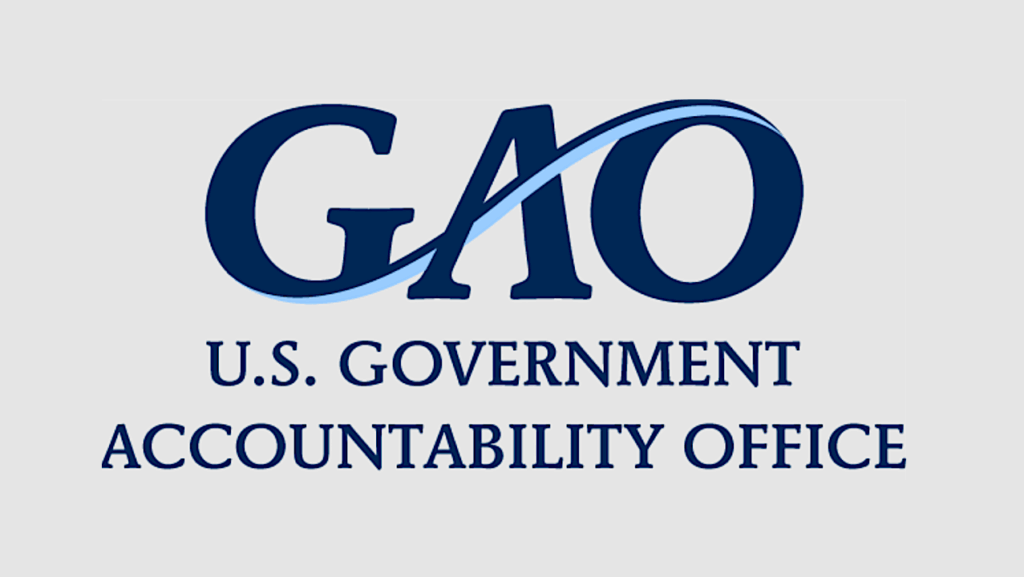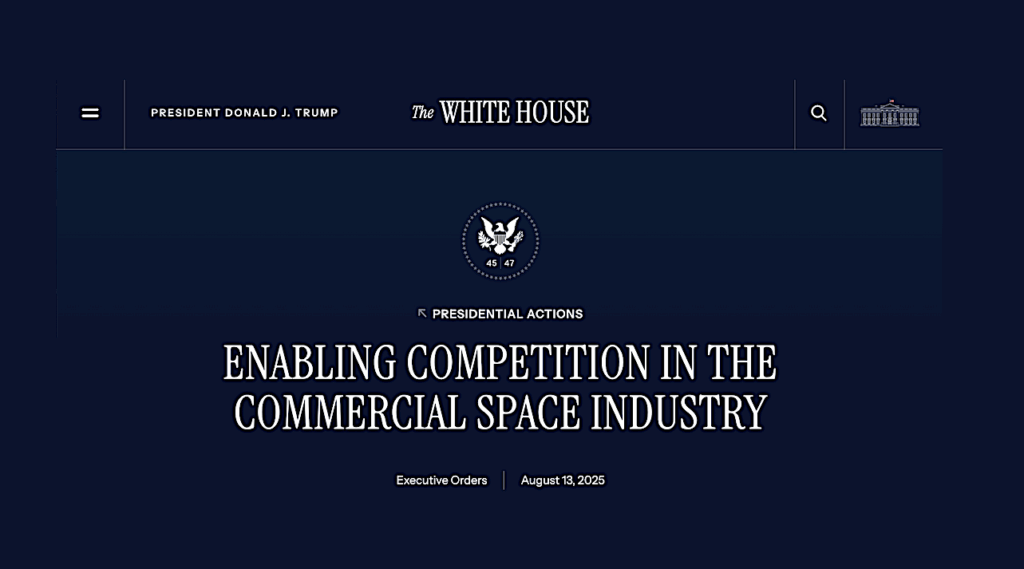Inspiration Mars Wants To Use ISS
 Volunteers Line Up For Tito’s Mars Flyaround, Aviation Week
Volunteers Line Up For Tito’s Mars Flyaround, Aviation Week
“Doug Cooke, a recently retired top NASA manager who spearheaded exploration-systems development for the agency, has joined the private group’s board advisors, MacCallum said. … MacCallum said work has already started on ground facilities to test the life support hardware, which will be largely crew tended for simplicity, but will be designed effectively to give two-fault-tolerant redundancy comparable to NASA safety standards. Eventually some components and subsystems probably will be tested on the International Space Station.”
 Keith’s note: Not that this is a bad idea (its actually a smart one since ISS is a great testbed), but who is going to pay to fly these systems to the ISS? Flying racks of hardware to the ISS is not exactly cheap.
Keith’s note: Not that this is a bad idea (its actually a smart one since ISS is a great testbed), but who is going to pay to fly these systems to the ISS? Flying racks of hardware to the ISS is not exactly cheap.
 Keith’s update: Out of curiosity, I have checked online sites for the State of California and IRS for non-profits – or regular companies named “Inspiration Mars Foundation” or variations thereof. Nothing results from these searchs. One might conclude that the organization does not yet exist despite what is on their website.
Keith’s update: Out of curiosity, I have checked online sites for the State of California and IRS for non-profits – or regular companies named “Inspiration Mars Foundation” or variations thereof. Nothing results from these searchs. One might conclude that the organization does not yet exist despite what is on their website.
 Keith’s update: Update: Inspiration Mars was incorporated in Delaware on 25 Jan 2013 as a Non-profit corporation – File #5279943 – but still no evidence of its 501(c)(3) status (probably in application phase).
Keith’s update: Update: Inspiration Mars was incorporated in Delaware on 25 Jan 2013 as a Non-profit corporation – File #5279943 – but still no evidence of its 501(c)(3) status (probably in application phase).
Earlier posts









I’m not sure you can make the jump from the quote in the article to them definitely wanting to use ISS. It would probably be cheaper to use Dragonlab for most of the system tests, if (and this is a big ‘if’) it is even strictly necessary to do it in LEO.
FWIW, though, I get the impression that Inspiration Mars is quickly picking up lots of veteran NASA and industry types who really, really want to turn this into an SLS-launched Orion mission. Time will tell if these types’ adherence to “SLS Way or No Way” will ultimately cripple the project.
Read the article. It quite clearly says “Eventually some components and subsystems probably will be tested on the International Space Station.”. I never said or wrote “definitely” as you seem to be quoting me. No one mentions Dragonlab.
And if it is launched by SLS, so what…
it is launched…
Debate regarding launch vehicle will doom the mission.
Does not matter what vehicle launches the IM spacecraft just as long as the mission is launched…
Who pays for the launch? Inspiration Mars? Taxpayers?
“Debate regarding launch vehicle will doom the mission.”
That’s nonsense. Thoughtlessly choosing one launch vehicle without considering all the ramifications might doom the mission.
Its not thoughtless choosing of a launch vehicle…
You choose the best vehicle…
My point is:
If the block 1 SLS is fully qualified to launch the Inspiration Mars mission and it is “given” or “sold” to the organization for this purpose,
then there should NOT be a divisive antagonistic debate about that…
You’re complaining about everyone else expressing any opinions that differ from yours. Any other opinion is apparently “divisive” and “antagonistic”.
Like Steve, I’m tiring of trying to respond to shrill rhetoric that doesn’t respect any different point of view.
Why not SLS, if given a choice of launching SLS-1 around the moon or setting off for interplanetary travel…
Would you really get in the way of using SLS for the Inspiration Mars mission if it were provided?
Wouldn’t you want the mission to go forward regardless of the launch vehicle, regardless if launched on SLS?
Point is that continued adversarial debate abou the program of record
I guess you don”t understand: Inspiration Mars is a private, commercial mission. SLS is a rocket built by the government for government missions. They can’t just give it to a private company – and each launch will be on the order of $1 billion. Also, since private companies can provide rockets to do this mission, if NASA sold an SLS to Inspiration Mars they’d be in violation of the Commercial Space Act which prohibits the government from competing with the private sector.
Inspiration Mars is not a *commercial* mission. It is a private, not-for-profit foundation that wants to carry out a scientific, philanthropic human exploration mission.
It is entirely possible that the mission will be carried out as a partnership with NASA (instead of just partnering with NASA on research that would enable the mission). In that case, the government can choose to “give” whatever it wants to the mission, including a launch vehicle or launch service.
The Commercial Space Act of 1998 does not allow the government (except in rare circumstances) to compete with the private sector in meeting *government* requirements. In other words, NASA is supposed to buy commercial launch services. As is the Department of Defense, under that law.
But it does not forbid the government from spending money to buy something and giving it to a private project. So long as the federal government determines that such a grant of a launch vehicle serves the public interest, i.e. taxpayers receive sufficient value for the expense, NASA can give IM an SLS launch, or a few hundred million dollars to buy one or more U.S. launch vehicles, to conduct the mission.
What prevents NASA from giving an SLS launch to IM… is the likelihood that SLS won’t be ready by January of 2018, almost certainly for budgetary reasons.
It is a commercial mission, Jim. And you are paid as one of Mr. Tito’s consultants on a commercial basis to promote it as you are doing here.
It is irrelevant as SLS will not launch in time to be of any use to Inspiration Mars. You work for Tito JIm, time to disabuse him of this notion so that you can get to work on a real solution to the problem.
Nobody has yet mentioned that the government decision makers who could make SLS available to IM, if it is indeed possible to do so, are either lawyers or are used to dealing daily with lawyers. This being the case, precedent (future precedent) is likely (in my opinion) to be the deciding factor.
In other words, would they consider giving away or making affordable an SLS more than once. Logic says, No, because of the outrageous cost.
However, each and every SLS built is an awful lot of pork to hand out in exchange for a lot of campaign contributions. It also represents a lot of jobs, if not created, at least retained for a little longer. And we’ve seen how quickly logic can go out out the window when pork and job protection are involved.
Personally, I’d almost consider it suicidal for IM to go with SLS, but I wouldn’t rule out the possibility of it being offered.
Just grateful Tito brought Jim aboard someone as articulate, informed, and passionate about ensuring the success of Inspiration Mars.
Regardless of launch option choices it is a relief to see so much enthusiasm here for Inspiration Mars.
I don’t think cost, or NASA restrictions, or even schedule are the deciding factors. It comes down to reliability and safety. What we’re talking about is the first-ever use of SLS, a misconceived, committee-designed huge rocket. I personally have absolutely no confidence that it will work properly on it’s first launch, or even it’s second or third.
The IM mission is a one-chance-only proposition. If the launch is anything less then perfect then the whole thing goes out the window, for ever. Trying again in 2031 is a meaningless option. Everything will have changed by then.
SLS doesn’t even have a prior version to judge by. It reuses Shuttle parts, but it is not anything like the Shuttle. It has absolutely no track record. Using SLS would be a kick in the teeth to the investors who are putting up a hell of a lot of money and who can reasonably expect that only the best available choices will be made.
Of course safety and reliability are the prime factors…
The problem I have is with the summary dismissal of SLS as a possible launch vehicle.
Use of it should not be precluded because one does not “like” the SLS system.
If dual Falcon 9 Heavy launches can launch the appropriate interplanetary gear into orbit, then lets go with that.
But, don’t dismiss SLS and get all angry about it even being considered just because you don’t like it.
It is one thing to not like a rocket and to express your opinion about it.
It is another thing to be obstructionist.
Use of it should not be dismissed because of the Space Commercial Act, that is a simply cop out. The parameters of the Space Commercial Act were established when the conception of this mission was not even on the drawing board. Does not take too much to create an exception for this mission.
Rockets are designed by committees all the time.
The US Senate provided parameters for NASA engineers to consider.
That’s no different from Ford’s board of directors giving it’s engineering team parameters from which to design a new Mustang.
“The problem I have is with the summary dismissal of SLS as a possible launch vehicle.”
Everyone who has argued against using SLS has given very good reasons for not using it.
“Use of it should not be precluded because one does not “like” the SLS system.”
Nobody here has said not to use SLS because they don’t like it. They’ve said it’s dumb to use for very good reasons.
“It is another thing to be obstructionist.”
These are discussions on a public forum by people who have no decision making ability at all about this project. How can that possibly be obstructionist?
“Use of it should not be dismissed because of the Space Commercial Act, that is a simply cop out.”
That’s illogical nonsense. Saying that something is illegal is not a cop out. It’s a very important point. Laws matter. NASA can’t just ignore the law. Only Congress can change the law, and that takes a lot of effort.
“The parameters of the Space Commercial Act were established when the
conception of this mission was not even on the drawing board. Does not
take too much to create an exception for this mission.”
Doesn’t take too much? Just a majority of the Senate, a majority of the House of Representatives, and the signature of the president. It’s not as if congress or the president have anything else to do, so I’m sure it won’t take too much to get them to all agree on on this.
“The US Senate provided parameters for NASA engineers to consider.”
No. Not even close. The Senate took all choice away from NASA engineers and ordered them to follow very specific design specifications.
“That’s no different from Ford’s board of directors giving it’s engineering team parameters from which to design a new Mustang.”
You apparently have no idea what the board of directors at Ford does. They would never in a million years order the engineering team for the new Mustang to make particular design decisions. You can be pretty sure that any company that was set up to have its board of directors make these kinds of engineering decisions would very quickly be bankrupt. Boards of directors don’t make engineering decisions. Boards of directors hire the CEO. The CEO hires the rest of the management team. The management team hires the engineers, and it is the engineers together with some of the management team that make the engineering design decisions.
“No. Not even close. The Senate took all choice away from NASA engineers and ordered them to follow very specific design specifications.”
Exactly, and the Senate is in no way qualified to make engineering-type decisions or design decisions. They are exactly the type of group that should NOT be making such decisions.
All of this stuff is true, but I’d cancel SLS based on operating cost alone, without having to add in all of these other factors.
Remember Saturn V. Remember Shuttle. Remember Constellation. Every one of them was declared too expensive to keep using — by the government. SLS will cost even more than any of the others to operate. But I’m pretty sure that yokohama2010 is not going to change his/her mind, so this is all leading nowhere.
We all spent a lot of time in years gone by rightly selling the importance of cost per kg to orbit; this whole argument with yokohama2010 is a giant step backward.
The cost of SLS isn’t to the payloads that will apparently get free launches, it’s the year delay (already) in commercial crew to “fully fund” SLS and Orion.
How does inspiration intend to use iss? Testing??? Shake out?? To add crew??? Couldn’t this be good to start using iss as a building site????
DTARS,
The actual statement was that they would probably test some of the components and subsystems on the ISS (not the whole spacecraft). This makes sense, since certain components need to be tested under their actual operating conditions (vacuum, temperature swings,…). In its original design incarnation as Space Station Freedom (way back in the early 80’s) this sort of testing was one of justifications given for building a station.
Using the ISS for a building site is another matter. It could be used as the “hotel” for a nearby construction site, but using the ISS itself to build anything is, I think, not practical because: 1) there isn’t the room, unless you add a large Bigelow hab; and 2) the ISS is not particularly robust structurally — large masses have to be added and/or moved carefully after calculating the loads and moments for each action, with little room for error. Although the station is big, it wouldn’t take too much in the way of torque to “snap” something. There has been debate about this over the years, but I figure as long as there are some engineers who say it’s a bad idea we should err on the side of caution. We would also have to look into whether it would effect sensitive on-board instruments and experiments; things as simple a vibration and drift might be problems (I don’t know if anyone has ever actually looked into that).
As far as using a Bigelow goes, I really don’t know what the limitations are on stressing the walls of these inflatables. Construction will involve massive and sharp objects being moved around inside. How much does it take to puncture a wall? What emergency equipment would have to be added to survive a large puncture? How hard is a wall repair? How often can a unit’s walls be repaired? etc? I don’t know the answers to this or if it’s even an issue.
Steve
Those are good points. I wonder how hard it would be to build a station that could handle some forces and vibrations better.
Still, the station does seem to be able to use its robotic arm to move some of its own components around from time to time, not to mention the occasional visiting capsule. If it can move a Dragon around, that sounds like a pretty useful capability for construction, even if the moves do have to be slow and planned out well in advance.
Agreed, Chris. I haven’t gone through all of the operations to check it out, but it seems to me that docking/birthing of spacecraft is always at the same points along the central (strongest) station axis, where space is limited and a Bigelow probably wouldn’t fit. The one “end” docking port used is one that they’re not going to want to give up (isn’t that the emergency return vehicle’s port?).
The other issue that I left out above is that adding any working volume large enough to be useful is also possibly going to occlude the solar panels for significant periods, reducing the station’s available power (safety issue?), when in fact doing construction will want more power.
I may be overcautious here, but I don’t see it happening. The capability to add something on the scale of a construction facility pretty much has to be a requirement specified at the outset and considered in the entire design. The AMS is a good example; it was known and allowed for long before it was installed.
See NASA Authorization Act of 1991 codified in Title 51
Subtitle VII. Access to Space. Chapter. 701 Use of Space Shuttle or Alternatives http://www.law.cornell.edu/…
I am assuming that unless amended, this chapter will govern commercial or non-NASA use of SLS, but note that SLS is not mentioned within the text of
the chapter and assumptions from headings often lead to the wrong
conclusion. What matters is the
intent of the drafters (i.e., Congress) in determining if SLS will apply.
§ 70102 states “It shall be the policy of the United States
to use the Space Shuttle (i) for
purposes that require a human presence; (ii) for
purposes that require the unique capabilities of the space shuttle; or (iii) when other compelling circumstances exist. “Compelling
circumstances” includes, but is not
limited to, occasions when the Administrator determines, in consultation
with the Secretary of Defense and the Secretary of State, that important
national security or foreign policy interests would be served by a shuttle
launch.”
§ 70103 states “Commercial
payloads may not be accepted for launch as primary payloads on the space
shuttle unless the Administrator determines that— (1) the
payload requires the unique capabilities of the space shuttle; or (2)
launching of the payload on the space shuttle is important for either national
security or foreign policy purposes.”
There is an argument as to what constitutes “commercial
payloads” within Chapter 701 because it does not give a definition of
commercial. Chapter 501. Space
Commerce. defines a “commercial provider” as any person providing space
transportation services or other space-related activities, primary control of
which is held by persons other than Federal, State, local, and foreign
governments.” The above definition
would apply automatically if it were defined in the definition section of the entire Title,
but since it is defined within a chapter it does not automatically apply to a
different chapter unless expressly written. This is another question of the intent of Congress and
whether a definition was purposely left out for broad interpretive purposes.
§ 70102 is an easy standard to meet if Inspiration Mars is
not considered “commercial” under the
chapter, but even if Inspiration Mars is considered commercial it can be argued that SLS use is justified
under § 70103. National security
and foreign policy purposes can easily validate a first of its kind mission
with the risk of being carried out by a foreign launch vehicle or agency. The objective of U.S. leadership in
space, as required by the NASA Act of 1958, would be served by NASA
involvement.
NASA could still be somewhat involved without its use of the
SLS. NASA has invested hundreds of
millions in SpaceX cargo and crew capabilities through the Commercial Crew and
Cargo Program and can take some credit for its use. ULA has also received considerable
amounts of NASA funding through the Commercial Crew Program. These options would only serve NASA with
more public awareness regarding its investments in the commercial space
industry.
I cannot speak to the other reasons why SLS may not be the
best option like time and cost.
Disclaimer: I
am a law student with an interest in space law and policy currently writing
papers focusing on the evolution of U.S. commercial space law and remote
sensing law. I am not a
lawyer.
Daniel,
Good research, well done — especially in comparison to the top-of-the-head guessing that most of us have done.
Tito’s definitions, as opposed to anyone else’s, appear to center on the terms “research” and “non-profit” (specifically 501(c)(3)). Unless these two terms are included in the Authorization Act that you’ve researched, then I guess the debate continues.
Also, be aware that the 1991 Act has been superseded by quite a few versions, and to be certain, each and every one of them would have to be reviewed in full to see if and of the relevant 1991 text has been updated, replaced or removed (unfortunately we can’t just check the matching paragraph numbers). This checking should be right up your alley since Act revisions are typically written in “lawyer talk” instead of English. Congress makes nothing easy.
Steve
Thanks Steve.
I believe the language originated in President Reagan’s National Security Decision Directive (NSDD)-254 after the Challenger explosion:
http://www.marshall.org/pdf…
See the last paragraph titled Implementation.
This evolved into the language from the enrolled bill which became the 91 Act:
http://thomas.loc.gov/cgi-b…
(a)(1) It shall be the policy of the United States to use the Space Shuttle for purposes that (i) require the presence of man, (ii) require the unique capabilities of the Space Shuttle or (iii) when other compelling circumstances exist.
(2) The term “compelling circumstances” includes, but is not limited to, occasions when the Administrator determines, in consultation with the Secretary of Defense and the Secretary of State, that important national security or foreign policy interests would be served by a Shuttle launch.
(3) The policy stated in subsection (a)(1) shall not preclude the use of available cargo space, on a Space Shuttle mission otherwise consistent with the policy described under subsection (a)(1), for the purpose of carrying secondary payloads (as defined by the Administrator) that do not require the presence of man if such payloads are consistent with the requirements of research, development, demonstration, scientific, commercial, and educational programs authorized by the Administrator.
The language in my earlier post is taken from the most recent 2010 NASA Authorization Act. The language is almost identical to §70102 but the heading “Space Shuttle Use or Alternatives” was inserted in the 2010 Authorization. Since SLS is an alternative to the Space Shuttle either §70102 or § 70103 apply depending on whether Inspiration Mars is commercial or not. “Research” and “non profit” would simply put IM in the non-commercial category and therefore under §70102 (research is mentioned in the text of §70102) which like earlier stated, could be easily justified under the criteria.I hope the reasoning makes as much sense as it sounded when I typed. I would like to do more research on draft language to the 2010 Authorization Act to determine where, when, and why “Alternatives” was introduced, because my entire argument relies on that word.
Daniel
The unique capability of the SLS is that it is the only launch vehicle we have that can launch payloads weighting more than 53 tonne to Low Earth Orbit (LEO). For destinations past LEO the maximum payload of the Falcon Heavy is smaller.
And just why pray tell do we need a launch vehicle with this throw weight in order to explore beyond LEO? Is it your position that there is no other way to send humans beyond LEO?
There is always another way, for instance you can use 3 launches instead of one. That is a cost and time trade off.
For beyond LEO work the 53 tonne launched by a Falcon Heavy is surprisingly small. Example LEO to lunar surface has a delta-V of 5.93 km/s, on a lander of Isp 321 seconds only 8.06 tonnes arrive including the lander.
Allowing a couple of tonne for the lander and your lunar items have to weigh less than 6 tonnes. That is very limiting.
Allowing a couple of tonne for the lander and your lunar items have to weigh less than 6 tonnes. That is very limiting.
It is only limiting if your idea of payloads are singular items larger than six tons. There are actually very few payloads in this class.
There are actually very few payloads in this class.
That is because the payloads have been limited to fit the launch vehicle. Manned payloads soon get that heavy.
The Habitat Demonstration Unit (DHU) weighs 6424 kg and sits on a cradle that weighs 3311 kg.
http://www.nasa.gov/explora…
The surface version of the MMSEV is close to this limit.
That is because the payloads have been limited to fit the launch vehicle. Manned payloads soon get that heavy.
I have been in the HDU many times. It is not even thought to be flight hardware. Manned payloads don’t have to be that heavy and or can be assembled in orbit.
I did the calculations a few years ago and for the development cost of the SLS you could put about 1,000,000 lbs on the Moon using existing vehicles. It would take 20 years at two flights per year afterward to even equal that amount of payload in to the lunar surface by SLS.
However we are spending very large sums of money developing the SLS.